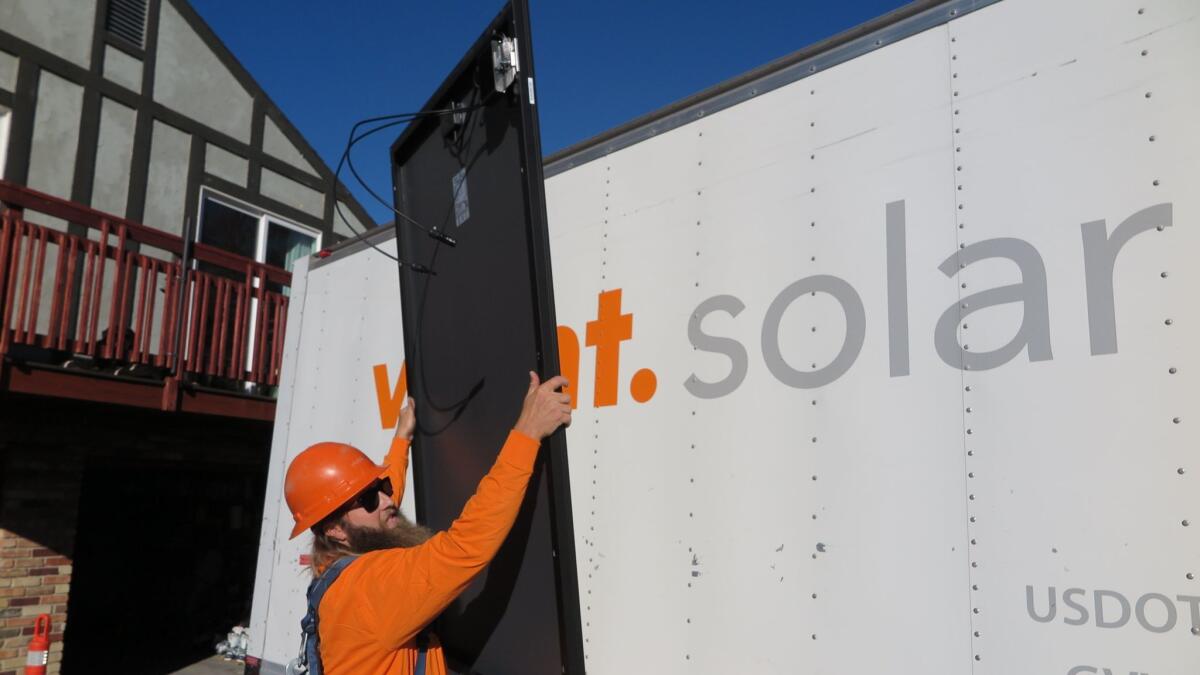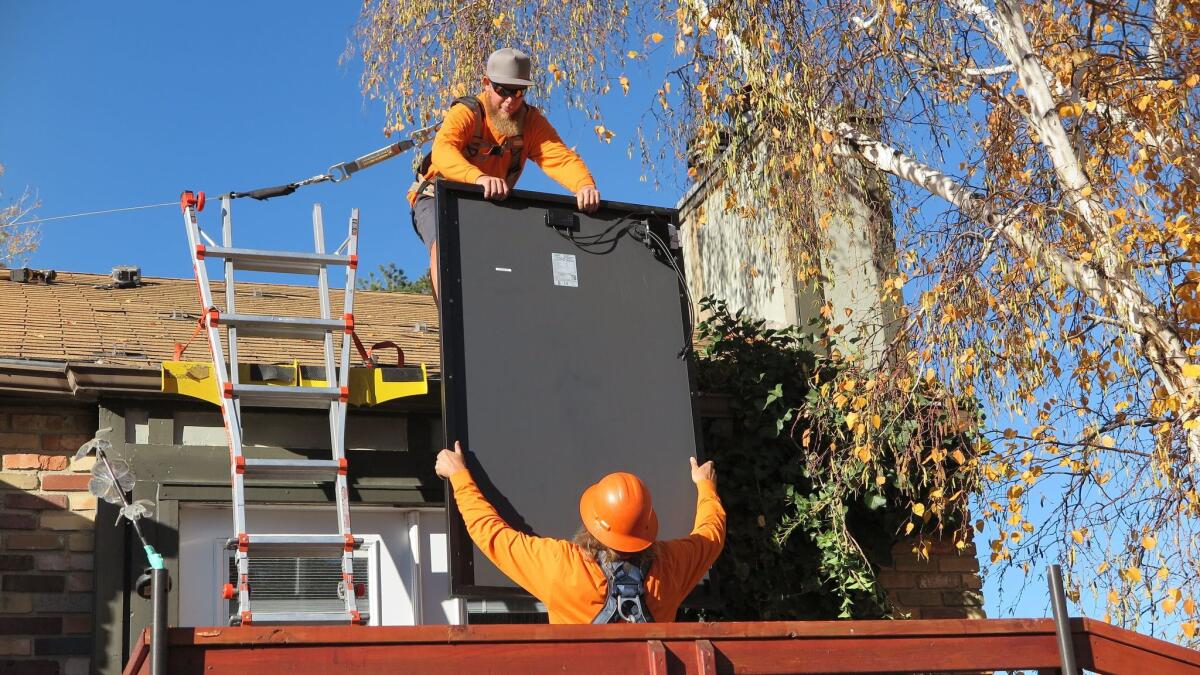Possible tariff on imported solar panels makes the industry nervous

- Share via
Reporting from Sandy, Utah — Until the last few weeks, Christopher Hanson’s work as a foreman installing rooftop solar systems was as bright and steady as the midmorning Wasatch Front sun. By his measure, Hanson has completed over 2,000 residential solar projects in his nearly five-year career, including one more he’s about to finish for Vivint Solar here in the suburbs south of Salt Lake City.
Now Hanson is nervous for his job. On Tuesday, the U.S. International Trade Commission is scheduled to start considering a tariff on imports of the most popular photovoltaic generating panels used in the booming U.S. residential and utility-scale solar markets. A stiff tariff could double the price of imported photovoltaic panels made from crystalline silicon, an outcome that is either calamitous or full of opportunity for the burgeoning solar industry, depending on how you look at it.
Two international solar panel producers with United States plants say they need protection from low-cost imports. Most of the industry, though, clamors to maintain a sure supply of inexpensive foreign panels to meet the rocketing demand for residential and industrial solar installations.
The trade commission’s decision will be transmitted to President Trump on Nov. 13. Whatever the outcome, the tariff case has riven the $30-billion U.S. solar sector and darkened Utah’s Wasatch Front — and almost every other region where solar-powered electrical generation is one of the brightest spots in industry.
Supporters of the tariff include Tempe, Ariz.-based First Solar, the largest U.S. solar panel producer, which uses cadmium-based “thin film” technology to manufacture equipment unaffected by the trade commission’s decision. The $2.95-billion company’s stock price soared in September after the trade commission found a tariff may be justified. First Solar’s orders outpace its ability to fill them well into 2018, and the company is building new manufacturing lines to double its production.
Most other solar industry executives and many utility companies join Hanson in opposing an import tariff.
“If it costs me my job, that would not be good,” said the bearded foreman. “If it costs this industry a lot more money and we lose business, that won’t be good either. It’s a concern. You just don’t know.”
The shadow of uncertainty started to develop in March when Suniva, the Hong Kong-based owner of solar panel plants in Georgia and Michigan, laid off 130 workers. On April 27, nine days after it declared bankruptcy, Suniva filed a petition asking the trade commission’s four commissioners to levy a tariff that could double the price of imported crystalline silicon components and equipment.

Last year, imported silicon panels supplied roughly 80% of the American market. Suniva was later joined in its appeal by SolarWorld Americas, a German-based firm that laid off 360 workers in July at its silicon photovoltaic panel plant in Hillsboro, Ore. Both companies argued that imported panels were so inexpensive that their U.S. manufacturing facilities could not compete.
The companies’ political allies include Rep. Dan Kildee, a Democrat from Flint, Mich., whose district includes one of the shuttered Suniva plants.
“I urge President Trump to act and support our manufacturers and workers,” Kildee said in a statement last spring. “In my district, we have already lost hundreds of Michigan jobs.”
In many other states, though, Suniva’s tariff petition has caused such a stir that authorities in the solar installation sector warn that it could force company closures, produce tens of thousands of job losses and seriously damage an industry that is a model of environmentally sensitive 21st century industrial development.
Starting as a niche energy industry less than a decade ago, the U.S. solar sector has grown to about 40 manufacturing plants, over 9,000 installation companies and 260,000 employees, according to the Solar Energy Industries Assn., the industry’s major trade group in Washington.
Last year, utility-scale solar stations produced 37% of new electrical generating capacity in the U.S., more than any other source of electricity, according to the Energy Information Administration, an Energy Department data group. The number of rooftop solar installations increased almost 20%. Solar firms added 14.7 gigawatts of new U.S. generating capacity in 2016, about the same amount as 15 big coal-fired generating stations. Only China added more.
Much of the growth is driven by the availability of imported solar panels, which cost a third of what they did four years ago and prices dropped still further until last summer. Imported solar panels were priced at about 35 cents a watt this year, or about $130 for a typical residential panel, and 50 to 55 cents a watt for a $190 utility-scale panel. Prices for both have climbed over 10% since spring.
Suniva has called for a tariff establishing a price of about 78 cents per watt — a proposal that has put the industry in turmoil. Utility-scale producers say the near future is so uncertain that activity on new projects has virtually ceased.
“It’s been very disruptive,” said Mark D. Marion, vice president for operations at juwi Americas, a German-owned company that built a $100-million, 50-megawatt generating station that opened in Utah last year. Such a large station typically incorporates 200,000 silicon panels that make up almost half the cost of the project. “We don’t know what the price of panels will be, and what our cost to build a project will be. The uncertainty is preventing utilities and developers from signing contracts.”

Residential solar companies are encountering the same turmoil. Vivint Solar, based in a new headquarters in Lehi, Utah, grew from a 2011 start-up to become a residential solar leader, with 4,000 employees in 20 states and $135 million in revenue last year. David Bywater, Vivint Solar’s chief executive, says the number of installations — 105 a day nationwide this year — appears to be falling as panel prices rise.
“I’m worried, and not just for our company,” he said. “Solar power is one of the few things that almost every American says, ‘Please do this. We support this.’ But it’s a fragile ecosystem. If the cost is increased, solar businesses will not be able to do what we do. The margins are thin.”
Trump has until Jan. 12 to act on the trade commission’s recommendation. Unlike the administration’s decisions to support fossil fuel development, which face stiff legal and legislative barriers, the president has near total authority to abide by the commission recommendation, to increase or lower the solar tariff level, or to reject it altogether.
“The President will examine the facts and make a determination that reflects the best interests of the United States,” the White House said in a statement in September. “The U.S. solar manufacturing sector contributes to our energy security and economic prosperity.”
Here in Sandy, members of Hanson’s crew are closely monitoring the case. Hugh Miller, an electrician, looked up briefly from his work preparing a junction box for the new solar array.
“Solar power is growing fast,” he said. “Anything that slows it down won’t make America great again.”
Follow me on Twitter @modeshift
ALSO
Under Trump, the lines are drawn for a battle over resources in the West
Trump positioned to impose potentially crushing tariffs on solar industry
Will a trade fight with Asia sabotage the U.S. solar industry? That may be up to Trump
From oil refineries to solar plants, unions bend California climate change policies in their favor
More to Read
Sign up for Essential California
The most important California stories and recommendations in your inbox every morning.
You may occasionally receive promotional content from the Los Angeles Times.









